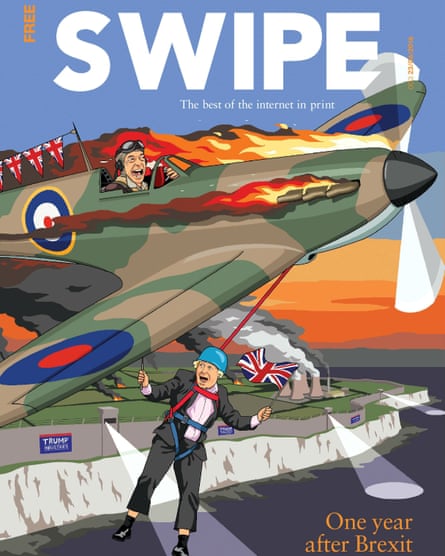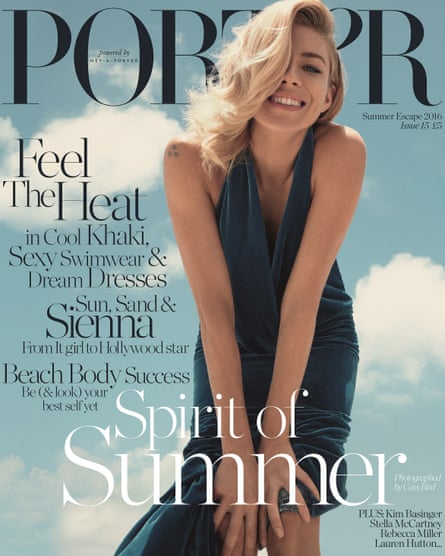The march of technological progress moves in just one direction. From analogue to digital. From standalone to connected. From print to online. That, at least, is the conventional view. The reality is far messier. And far more interesting.
During the first dotcom boom, I liked to invoke the counterfactual. What if the physical succeeded the digital? What if the virtual retailer came first, followed by the high street store – how would we have greeted the latter? Surely we would have celebrated our new ability to touch and feel – to say nothing of trying on for size – the clothes we were about to buy. Talk about a paradigm shift.
It is in that spirit of the counterfactual – or, at least, the counterintuitive – that Swipe, a new London-based, fortnightly freesheet, is promising to package “the best of the internet in print”. It’s not the first to make this reverse journey from digital to print – Politico, for example, launched a print magazine in November 2013 while digital fashion retailer Net-a-Porter followed suit three months later with Porter – but it is the latest.
Launched at the end of May, Swipe is run by millennials for millennials. Its publisher, Tom Rendell, is 28, which puts him squarely in the 18- to 35-year-old target demographic. “[It’s a] commuting, time poor, early adopter audience,” says Rendell.
Of Swipe’s 20,000 print run, 17,000 are handed out at 23 tube stations across London, plus the odd overground station, skewed towards the capital’s centre and southeast. By the second issue, its by-hand pick-up rate was a healthy 72.5%.
Advertising and content marketing-supported, Swipe features long and short articles, repurposed from nearly 100 web publications including Aeon, Business Insider, The Conversation, The Pool and The Next Web. Publishers get final copy approval and are paid 10p per word (15 cents per word for US publishers). This is hardly a financial game-changer so perhaps promotion, not profit, is the real attraction – an author byline, logo, URL and Twitter address accompany every article.
“The key is helping the online publishers find new audiences,” says Rendell. One of the problems with online, he says, is that it rewards those who know their search engine optimisation and social media marketing rather than, necessarily, rewarding quality. Magazine curation is a way to bypass this “filter bubble” and help time-poor readers discover something worthwhile.
While Rendell believes there has been a spike in the quality of online journalism – “Buzzfeed has gone from listicles to breaking international scoops,” he offers as an example. He says there is still a desire to read in print, pointing to a 2015 survey that suggested 81% of us prefer to do so.
What of the decision to restrict each issue to just one long read? It seems an odd choice, to this non-millennial at least, since the long-form article and the lean-back experience of print (no messaging alerts or hyperlinks to distract) are natural partners. Rendell says the team is fans of the long read but it’s important to get the balance right to ensure there’s “enough snackable content” for the Thursday morning commuter.

Like its cover price, the audience for Porter is markedly different from that of Swipe. Aimed at high-earning fashionistas, it launched in February 2014. After polling her users, Tess Macleod Smith, vice president of publishing and media at Net-a-Porter, knew there was an appetite for the “tactility, the look and feel of print”. Today, the bi-monthly Porter is available in 220 cities across 60 countries and costs £5, $9.99 or €9.99, depending where you are. It has a combined print and digital circulation of 170,000. This includes 40,000 subscribers, half of whom are Net-a-Porter’s biggest spenders who receive the magazine for free.
From the beginning, Macleod Smith says, Net-a-Porter set about creating a hybrid product. “Porter is like our bricks and mortar,” she says. To that end, readers can scan and buy the fashions they see in the magazine – or “inspirational ideas” based on what they see – via an iPhone and iPad app. There are 5,000 items associated with every issue.
“When we launched, fashion magazines weren’t talking about fashions available to buy there and then,” Macleod Smith says. “The consumer had to wait weeks before what they could buy in the shop. We changed that to ‘what you see, you can buy’.”

To date, 32,000 orders have been made through Porter. There are other benefits too, says Macleod Smith. She claims that magazine subscribers shop with them five times a year compared with twice a year for the average Net-a-Porter visitor. Moreover, given that 40% of new Porter subscribers are also new to the online retailer, the magazine “acts as an acquisition tool”.
Both Swipe and Porter are meshing print and digital and upsetting the natural order of technology progress. When Porter was first launched, Net-a-Porter founder Natalie Massenet said of her new creation: “You can bend it. It has incredible resolution – on both sides – and the battery life, well, it never runs out.”
Jon Bernstein is an independent digital media consultant, editor and writer, formerly deputy editor, then digital director of New Statesman and multimedia editor at Channel 4 News. He tweets @jon_bernstein
To get weekly news analysis, job alerts and event notifications direct to your inbox, sign up free for Media & Tech Network membership.
All Guardian Media & Tech Network content is editorially independent except for pieces labelled “Paid for by” – find out more here.

Comments (…)
Sign in or create your Guardian account to join the discussion